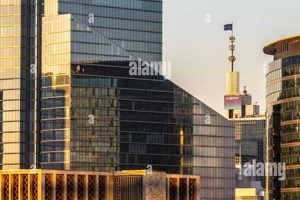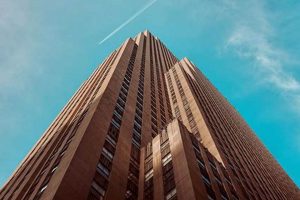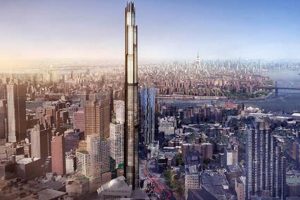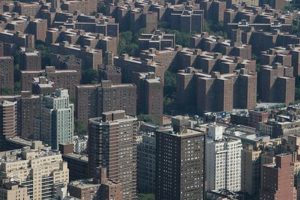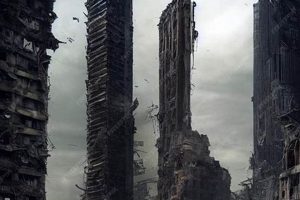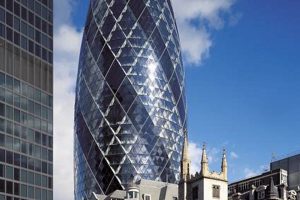A skyscraper fire is a fire that occurs in a high-rise building, typically one that is at least 50 stories tall. Skyscraper fires are particularly dangerous because they can spread quickly and cause a large amount of damage and loss of life. Some well-known skyscraper fires include the 1911 Triangle Shirtwaist Factory fire in New York City, which killed 146 people, and the 2007 Windsor Tower fire in Madrid, Spain, which killed 20 people.
Skyscraper fires are often difficult to extinguish because they can occur at great heights and because the buildings are often filled with combustible materials. Firefighters may also have difficulty accessing the fire from the ground, and water pressure may be insufficient to reach the upper floors of the building. As a result, skyscraper fires can often cause extensive damage and loss of life.
There are a number of things that can be done to prevent skyscraper fires, including installing fire sprinklers and fire alarms, using fire-resistant materials in construction, and developing emergency evacuation plans. It is also important to educate occupants of high-rise buildings about the dangers of fire and how to prevent it.
1. Height
The height of skyscrapers is a major factor in the difficulty of fighting fires in these buildings. Firefighters may have difficulty reaching the upper floors of a skyscraper with their equipment, and water pressure may be insufficient to reach the upper floors. This can make it difficult to extinguish a fire before it spreads and causes significant damage.
- Firefighting challenges: Firefighters face a number of challenges when fighting fires in skyscrapers, including the height of the building, the presence of combustible materials, and the difficulty of evacuating people from the building. As a result, skyscraper fires can be very difficult to extinguish, and can often cause extensive damage and loss of life.
- Evacuation challenges: In the event of a fire, it can be difficult to evacuate people from a skyscraper, especially from the upper floors. This is because the stairs and elevators may be blocked by fire or smoke, and people may have to walk down many flights of stairs to reach safety. As a result, it is important for people who live or work in skyscrapers to be familiar with the fire escape plans and to practice evacuating the building.
- Water pressure challenges: Water pressure may be insufficient to reach the upper floors of a skyscraper in the event of a fire. This is because water pressure decreases with height, and the upper floors of a skyscraper may be hundreds of feet above the ground. As a result, firefighters may have to use special equipment to get water to the upper floors of a skyscraper.
- Building design challenges: The design of a skyscraper can also make it difficult to fight fires. For example, skyscrapers often have large atriums and open spaces, which can allow fire to spread quickly. In addition, the exterior of a skyscraper may be made of materials that are difficult to penetrate, which can make it difficult for firefighters to reach the fire.
Despite the challenges, there are a number of things that can be done to make skyscrapers safer in the event of a fire. These include installing fire sprinklers and fire alarms, using fire-resistant materials in construction, and developing emergency evacuation plans. By taking these steps, we can help to reduce the risk of skyscraper fires and protect the lives of the people who live and work in these buildings.
2. Combustible materials
The presence of combustible materials in skyscrapers is a major factor in the spread of fires in these buildings. These materials can include furniture, carpeting, and other interior finishes, as well as the building’s structure itself. When a fire starts in a skyscraper, it can quickly spread to these materials and cause the fire to grow out of control.
- Rapid fire spread: Combustible materials can quickly spread fire throughout a skyscraper, making it difficult to contain and extinguish. This is because these materials are often lightweight and can be easily ignited, and they can release large amounts of heat and smoke when they burn.
- Challenges for firefighters: The presence of combustible materials in skyscrapers can make it difficult for firefighters to do their job. These materials can produce thick smoke and heat, which can make it difficult for firefighters to see and breathe. In addition, combustible materials can collapse and fall, creating additional hazards for firefighters.
- Evacuation challenges: Combustible materials can also make it difficult for people to evacuate a skyscraper in the event of a fire. These materials can block stairwells and exits, and they can produce large amounts of smoke and heat, which can make it difficult for people to breathe and see.
To mitigate the risks associated with combustible materials in skyscrapers, it is important to use fire-resistant materials in construction and to install fire sprinklers and fire alarms. Fire-resistant materials can help to slow the spread of fire, and fire sprinklers and fire alarms can help to detect and suppress fires early on. By taking these steps, we can help to make skyscrapers safer in the event of a fire.
3. Wind
Wind is a major factor in the spread of skyscraper fires. High winds can fan the flames of a fire and cause it to spread more quickly. This is especially dangerous in skyscrapers, where fires can spread rapidly through the building’s exterior cladding and interior structure. Wind can also make it more difficult for firefighters to control a fire, as it can push smoke and flames away from them.
There are a number of real-life examples of how wind has contributed to the spread of skyscraper fires. For example, the 2007 Windsor Tower fire in Madrid, Spain, was spread by high winds, which caused the fire to jump from one floor to another. The 2012 Burj Khalifa fire in Dubai, UAE, was also spread by high winds, which caused the fire to spread up the exterior of the building.
Understanding the connection between wind and skyscraper fires is important for a number of reasons. First, it helps us to understand how fires can spread in skyscrapers and how to prevent them from spreading. Second, it helps us to develop strategies for fighting fires in skyscrapers. Third, it helps us to design skyscrapers that are more resistant to wind-driven fires.
4. Water pressure
In the event of a skyscraper fire, water pressure may be insufficient to reach the upper floors of the building. This can make it difficult to extinguish the fire and can lead to the loss of life and property. There are a number of factors that can contribute to insufficient water pressure in skyscrapers, including the height of the building, the size of the water mains, and the demand for water from other buildings in the area.
- Height of the building: The height of a skyscraper can make it difficult for water to reach the upper floors. This is because water pressure decreases with height, and the upper floors of a skyscraper may be hundreds of feet above the ground. As a result, firefighters may have to use special equipment to get water to the upper floors of a skyscraper.
- Size of the water mains: The size of the water mains in a city can also affect water pressure in skyscrapers. If the water mains are too small, they may not be able to provide enough water to meet the demand from all of the buildings in the area. This can lead to low water pressure in skyscrapers, especially during peak demand periods.
- Demand for water from other buildings: The demand for water from other buildings in the area can also affect water pressure in skyscrapers. If there are a lot of other buildings in the area that are using water at the same time, this can reduce the amount of water available to skyscrapers. This can lead to low water pressure in skyscrapers, especially during peak demand periods.
Insufficient water pressure in skyscrapers can have a number of serious consequences. First, it can make it difficult to extinguish fires. This can lead to the spread of the fire and can result in the loss of life and property. Second, insufficient water pressure can make it difficult to evacuate people from a skyscraper in the event of a fire. This is because the stairs and elevators may be blocked by fire or smoke, and people may have to walk down many flights of stairs to reach safety. Third, insufficient water pressure can make it difficult to fight fires in other buildings in the area. This is because the water supply may be diverted to the skyscraper, leaving other buildings without adequate water to fight fires.
There are a number of things that can be done to address the problem of insufficient water pressure in skyscrapers. These include installing larger water mains, increasing the capacity of water pumps, and installing fire sprinklers and fire alarms. By taking these steps, we can help to ensure that there is adequate water pressure to fight fires in skyscrapers and to protect the lives of the people who live and work in these buildings.
5. Evacuation
Evacuating people from a skyscraper in the event of a fire can be difficult, especially from the upper floors. There are a number of factors that can contribute to this difficulty, including the height of the building, the design of the building, and the number of people in the building.
- Height of the building: The height of a skyscraper can make it difficult to evacuate people from the upper floors. This is because it can take a long time to walk down many flights of stairs, and elevators may not be available or may be too crowded to use. In addition, the smoke and heat from a fire can make it difficult to breathe and see, which can slow down evacuation.
- Design of the building: The design of a skyscraper can also affect the difficulty of evacuation. For example, buildings with narrow stairwells or long corridors can make it difficult for people to move quickly. In addition, buildings with a lot of open space can allow fire to spread quickly, which can make it more difficult to evacuate people from the upper floors.
- Number of people in the building: The number of people in a skyscraper can also affect the difficulty of evacuation. Buildings with a large number of occupants can be difficult to evacuate quickly, especially if there is a fire or other emergency. This is because it can take a long time for everyone to get out of the building, and there may be congestion at stairwells and exits.
- Other factors: In addition to the factors listed above, there are a number of other factors that can affect the difficulty of evacuation from a skyscraper. These factors include the availability of fire alarms and sprinklers, the training of building occupants, and the response time of emergency responders.
It is important to be aware of the challenges of evacuating from a skyscraper in the event of a fire. By being prepared and knowing what to do, you can help to ensure your safety and the safety of others.
6. Firefighting
Fighting a fire in a skyscraper is difficult and dangerous for firefighters due to several factors:
- Height: Skyscrapers are very tall, which means that firefighters have to climb many flights of stairs to reach the fire. This can be physically exhausting, especially in heavy gear. In addition, the smoke and heat from the fire can make it difficult to breathe and see, which can slow down firefighters and make it more difficult to locate and extinguish the fire.
- Materials: Skyscrapers are often made of combustible materials, such as wood, paper, and plastic. These materials can quickly catch fire and spread the flames throughout the building. In addition, the exterior of a skyscraper may be made of glass or metal, which can reflect heat and make it difficult for firefighters to get close to the fire.
- Water pressure: Water pressure may be insufficient to reach the upper floors of a skyscraper. This can make it difficult to extinguish the fire and can put firefighters at risk.
- Evacuation: It can be difficult to evacuate people from a skyscraper in the event of a fire. This is because the stairs and elevators may be blocked by fire or smoke, and people may have to walk down many flights of stairs to reach safety. This can be especially difficult for people with disabilities or young children.
Firefighting in a skyscraper requires specialized training and equipment. Firefighters must be able to work in high-rise buildings and use specialized equipment to fight fires. They must also be able to work in teams and coordinate their efforts to extinguish the fire and rescue people.
Despite the challenges, firefighters play a vital role in protecting people and property from skyscraper fires. They are highly trained and equipped to handle these dangerous situations, and they are always ready to put their lives on the line to save others.
7. Prevention
Preventing skyscraper fires is crucial to ensure the safety of occupants and minimize potential damage. Several key measures can significantly reduce the risk of fires and their devastating consequences.
- Fire Sprinklers and Fire Alarms:
Fire sprinklers and fire alarms are essential components of a comprehensive fire safety system in skyscrapers. Sprinklers automatically activate when a fire is detected, releasing water to contain and extinguish the flames. Fire alarms alert occu
pants and emergency responders to the presence of a fire, enabling prompt evacuation and response. Implementing these systems in skyscrapers helps prevent fires from spreading and provides early warning for timely action. - Fire-Resistant Materials:
Utilizing fire-resistant materials in the construction of skyscrapers is paramount to preventing the spread of fire. These materials, such as concrete, steel, and fire-rated glass, can withstand high temperatures and flames for extended periods. By incorporating fire-resistant materials in structural elements, interior finishes, and exterior cladding, skyscrapers can significantly reduce the risk of fire propagation and structural collapse.
- Emergency Evacuation Plans:
Well-developed and regularly practiced emergency evacuation plans are vital for skyscraper safety. These plans outline specific procedures and routes for occupants to follow in the event of a fire. Clear signage, illuminated pathways, and designated assembly points facilitate efficient evacuation, ensuring the safety of building occupants and minimizing potential panic or confusion during an emergency.
- Building Codes and Regulations:
Stringent building codes and regulations play a critical role in fire prevention and safety in skyscrapers. These codes establish minimum standards for fire-resistant construction, sprinkler systems, fire alarms, and emergency evacuation plans. Regular inspections and enforcement of these codes ensure that skyscrapers meet the necessary safety requirements and provide a reasonable level of protection for their occupants.
By implementing a combination of these preventive measures, we can significantly enhance the fire safety of skyscrapers, protecting lives, property, and the integrity of these iconic structures.
8. Preparedness
Preparedness plays a crucial role in mitigating the risks associated with skyscraper fires. By developing a comprehensive emergency plan and practicing evacuation procedures, occupants can significantly improve their chances of survival in the event of a fire. An emergency plan should outline specific actions to be taken in case of a fire, including escape routes, designated assembly points, and communication protocols. Regular evacuation drills help familiarize occupants with these procedures, ensuring a swift and coordinated response during an actual emergency.
The importance of preparedness is underscored by numerous real-life examples. The 1991 fire at the One Meridian Plaza skyscraper in Philadelphia serves as a cautionary tale. The lack of a comprehensive emergency plan and inadequate evacuation procedures resulted in the tragic loss of three lives. In contrast, the successful evacuation of the World Trade Center towers on 9/11 is a testament to the effectiveness of preparedness measures. Despite the unprecedented nature of the attacks, the well-practiced evacuation procedures enabled thousands of occupants to escape safely.
Understanding the connection between preparedness and skyscraper fire safety has practical significance. By investing in preparedness measures, building owners and managers can create a safer environment for occupants and reduce the potential for catastrophic outcomes. Emergency plans and evacuation drills empower individuals to take an active role in their own safety and contribute to the overall resilience of the building community.
In conclusion, preparedness is an essential component of skyscraper fire safety. Developing emergency plans and practicing evacuation procedures are proactive steps that can save lives in the event of a fire. By prioritizing preparedness, we can minimize the risks associated with these iconic structures and ensure the safety of those who live, work, and visit skyscrapers.
9. Response
When a skyscraper fire occurs, a swift and coordinated response is crucial to ensure the safety of occupants and minimize the risk of severe consequences. Emergency responders play a vital role in managing these incidents, and their instructions should be followed promptly and carefully.
- Evacuation Procedures:
In the event of a skyscraper fire, emergency responders will provide specific instructions on evacuation procedures. These instructions should be followed calmly and orderly to ensure the safe and efficient evacuation of all occupants. Ignoring or deviating from these instructions can lead to confusion, delays, and increased risk.
- Designated Assembly Points:
Emergency responders will designate specific assembly points outside the building where occupants should gather after evacuating. These assembly points serve as a central location for headcount, communication, and further instructions. Following the instructions to proceed to the designated assembly point allows emergency responders to account for all occupants and provide necessary assistance.
- Fire Safety Equipment:
Emergency responders may instruct occupants to use fire safety equipment, such as fire extinguishers or fire hoses, to help contain or suppress the fire. Following these instructions requires proper training and understanding of the equipment’s operation. Using fire safety equipment improperly can put individuals at risk and hinder firefighting efforts.
- Stay Informed:
Emergency responders will provide ongoing updates and instructions throughout the incident. It is crucial for occupants to stay informed and follow these instructions as the situation evolves. Listening to official announcements and staying updated on the latest information helps ensure the safety and well-being of all.
Responding appropriately to skyscraper fires requires a combination of preparedness, cooperation, and trust in emergency responders. Understanding the importance of following their instructions can significantly improve the chances of successful evacuation and minimize the potential for harm.
Skyscraper Fire FAQs
Skyscraper fires are a serious threat to public safety, but there are steps that can be taken to prevent them and mitigate their effects. Here are answers to some frequently asked questions (FAQs) about skyscraper fires:
Question 1: What are the biggest challenges in fighting skyscraper fires?
Skyscraper fires present unique challenges for firefighters due to their height, the presence of combustible materials, and the difficulty of evacuating occupants. The height of skyscrapers makes it difficult to reach the upper floors, and the presence of combustible materials can cause the fire to spread quickly. Evacuating occupants can also be difficult, especially from the upper floors.
Question 2: What can be done to prevent skyscraper fires?
There are a number of things that can be done to prevent skyscraper fires, including installing fire sprinklers and fire alarms, using fire-resistant materials in construction, and developing emergency evacuation plans. Fire sprinklers and fire alarms can help to detect and suppress fires early on, and fire-resistant materials can help to slow the spread of fire. Emergency evacuation plans can help to ensure that occupants know what to do in the event of a fire.
Question 3: What should you do if you are in a skyscraper when a fire occurs?
If you are in
a skyscraper when a fire occurs, the most important thing to do is to remain calm and follow the instructions of emergency responders. Evacuate the building immediately and proceed to the designated assembly point. Do not use elevators, as they may be out of service or become trapped. If you are unable to evacuate, stay in a safe place and call for help.
Question 4: How can we improve the safety of skyscrapers in the event of a fire?
There are a number of things that can be done to improve the safety of skyscrapers in the event of a fire, including installing fire sprinklers and fire alarms, using fire-resistant materials in construction, and developing emergency evacuation plans. Additionally, regular fire drills can help to ensure that occupants are familiar with the evacuation procedures and know what to do in the event of a fire.
Question 5: What are the most common causes of skyscraper fires?
The most common causes of skyscraper fires include electrical malfunctions, smoking materials, and cooking fires. Electrical malfunctions can occur due to faulty wiring or equipment, and smoking materials can ignite furniture or other combustible materials. Cooking fires can occur when food is left unattended on the stove or in the oven.
Question 6: What are the biggest challenges in evacuating people from a skyscraper during a fire?
The biggest challenges in evacuating people from a skyscraper during a fire include the height of the building, the presence of smoke and heat, and the potential for people to become trapped. The height of the building can make it difficult to evacuate people from the upper floors, and the presence of smoke and heat can make it difficult to see and breathe. People may also become trapped if stairwells or elevators are blocked by fire or debris.
By understanding the risks associated with skyscraper fires and taking steps to prevent them, we can help to keep our communities safe.
Transition to the next article section…
Skyscraper Fire Safety Tips
Skyscraper fires can be extremely dangerous, but there are steps you can take to stay safe in the event of a fire. Here are five tips to help you prepare for and respond to a skyscraper fire:
Tip 1: Know the fire escape plan for your building.
Every skyscraper should have a fire escape plan in place. Make sure you know the plan for your building and practice it regularly. In the event of a fire, follow the plan and evacuate the building immediately.
Tip 2: Stay calm and follow the instructions of emergency responders.
If you are in a skyscraper when a fire occurs, it is important to stay calm and follow the instructions of emergency responders. Do not panic and try to evacuate the building on your own. Emergency responders are trained to handle these situations and will be able to guide you to safety.
Tip 3: Use the stairs, not the elevators.
In the event of a fire, never use the elevators. Elevators can become trapped or disabled, putting you at risk. Always use the stairs to evacuate the building.
Tip 4: Close all doors and windows behind you as you evacuate.
This will help to contain the fire and prevent it from spreading to other parts of the building.
Tip 5: If you are unable to evacuate, stay in a safe place and call for help.
If you are unable to evacuate your building, stay in a safe place, such as a closed room with a window. Call for help and wait for emergency responders to arrive.
By following these tips, you can help to stay safe in the event of a skyscraper fire.
Remember:
- Prevention is always better than cure.
- Educate yourself about fire safety measures and follow them diligently.
- Stay alert and report any suspicious activities or potential fire hazards to the authorities.
Together, we can prevent skyscraper fires and ensure the safety of our communities.
Return to the article…
Skyscraper Fire
Skyscraper fires pose significant challenges to public safety due to their height, the presence of combustible materials, and the difficulty of evacuating occupants. To mitigate these risks, it is crucial to prioritize fire prevention measures, including installing fire sprinklers and alarms, using fire-resistant materials in construction, and developing comprehensive emergency evacuation plans. Preparedness is also essential, as occupants must be familiar with evacuation procedures and follow the instructions of emergency responders in the event of a fire.
In the aftermath of a skyscraper fire, a thorough investigation should be conducted to determine the cause and identify areas for improvement in fire safety regulations and building design. By learning from past incidents and continuously enhancing our safety measures, we can work towards preventing future tragedies and ensuring the safety of our communities.


